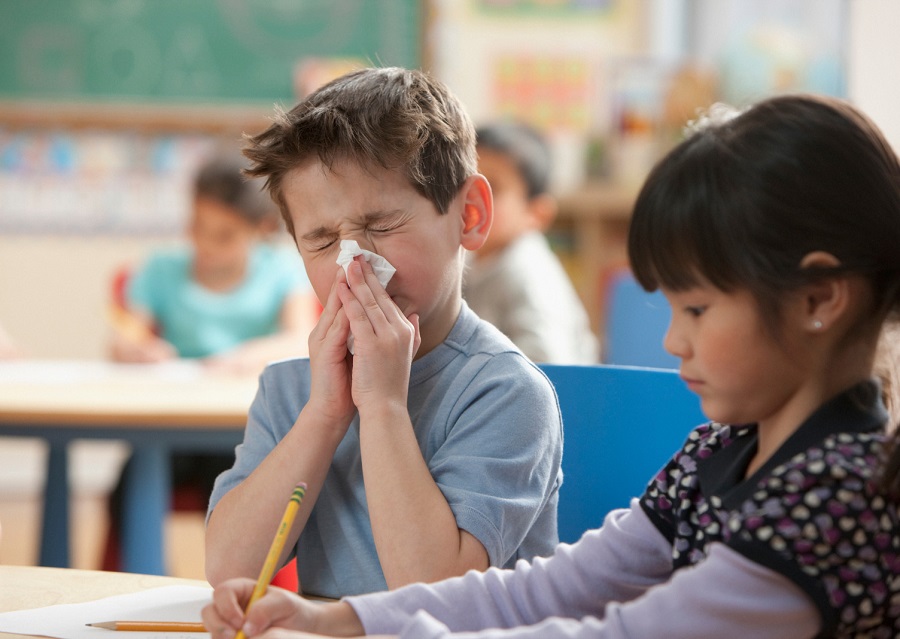- Community & News
- Conditions & Care
- Orthopedics
- Patient Stories
- Service Line
- Treatments
Spring into Action to Ease your Child’s Allergies

Springtime is the season of blooming trees and flowers, new grass, sunshine – and unfortunately for some children – allergies.
Seasonal allergies associated with outdoor mold and pollen can be a challenge, because kids want to go out and play as the weather warms up.
Kids who are allergy-prone can and should play outside as much as possible. Parents just need to monitor outdoor conditions and set limitations.
Mold and pollen readings for your city are readily available online:
Levels typically rise in mid-March and subside by May or June. They re-emerge in the early fall.
Allergies or a Cold?
Allergies cause watery eyes, sneezing and an itchy, runny nose with clear nasal secretions. The common cold can cause similar symptoms but also may include discolored nasal secretions, a sore throat and body aches.
Over-the-counter medications can be helpful for allergies, but it’s important to know which kind to use and how long to use them. Most now come in a non-drowsy formula, so they shouldn’t affect your child’s schoolwork or normal sleep patterns.
Medication Tips
With over-the-counter medications, look for antihistamines or decongestants for allergies. As always, read labels carefully and talk with your child’s doctor if you have any questions.
Antihistamines, available in either oral or nasal spray, target a chemical called histamine, which your body produces as a reaction to an allergen. They are most effective if given before the onset of symptoms.
Some over-the-counter pills and nasal sprays may also contain a decongestant. You’ll see a “D” after the name.
Decongestants are good only for short-term relief. They cut down on the fluid in the lining of the nose, which makes breathing easier, but after about three days they begin to have a “rebound” effect that causes swelling and makes breathing more difficult.
Indoor Allergies
Besides seasonal (outdoor) allergies, there are also perennial (indoor) allergies, caused by conditions in the home such as mold, dust, dust mites and pets.
One home hint: opening up windows to let in fresh air can be tempting but also detrimental. It invites in pollen and mold from trees and grass and also kicks up the dust and other allergens (including pet dander and saliva) in the home. The most important room to be allergen-free and pet-free is your child’s bedroom.
If over-the-counter antihistamine medications don’t alleviate symptoms, call your pediatrician. Other treatment options that can be prescribed by your pediatrician include nasal steroid sprays or eye drops that contain antihistamine. For more severe cases, allergy shots might be warranted.
Allergens from cats and dogs
About a third of American homes have a dog, and slightly fewer have a cat. But cats are two times more likely to prompt an allergic reaction. According to the American Lung Association, there is little difference between short-haired and long-haired pets, and no breed of dog or cat is immune from spreading allergens.
How do pet allergies work?
The culprit is not your dog or cat’s hair. It’s dander and saliva. Dander is tiny bits of skin shed by pets that can become airborne and can settle in your child’s nose and throat. Saliva contains a tiny protein that is sticky and so light it too can become airborne, clinging to your hair, clothes and items around the house. Dried saliva containing this allergen can flake off from an animal's fur.
Seamless Health Care for All Stages of Childhood
Finding the right doctor is an important first step in your child’s care. Our physicians are committed to providing compassionate, high-quality care from birth until adulthood. TriHealth provides comprehensive, patient-centered care for children and their families with Cincinnati's largest network of primary care pediatric providers.
Article provided by Denise Warrick, MD, MEd, Pediatrician, Associate Medical Director for Pediatrics